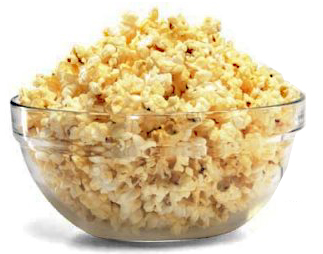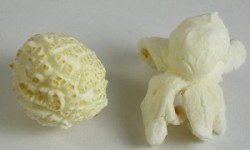Why Popcorn Pops
 Today I found out why popcorn pops.
Today I found out why popcorn pops.
First a little background, Popcorn or “zea mays everta” is a special kind of Flint corn, also known as “Indian corn” and sometimes “Calico corn”. Flint corn is readily recognizable as the kernels have a hard outer shell, likened to flint, hence the name. This hard outer shell is essential in making popcorn kernels pop. In fact, popcorn is the only type of corn that will pop.
So why does popcorn pop? There are three main elements of popcorn that have to come together to produce popcorn kernels that are good for popping. Those three elements are: the percentage of water content; hard, undamaged, water impermeable shell; and a starchy center.
When the kernels are heated up, the water inside begins to steam. Assuming the water impermeable shell doesn’t have any cracks in it to let the steam escape, this creates a simple little steam/pressure cooker. The starch inside the kernel then turns into a kind of gel-like substance as a result of this. Eventually, the pressure of the steam gets so great that the hard shell bursts, typically around 135 psi. When this happens, the steam rapidly expands, which results in the gel expanding out and hardening into airy foam. What’s going on here is that as the gelatinized starch expands, it forms thin airy bubbled jelly. These jelly bubbles will fuse together and then solidify very quickly as they are exposed to air and cool off. The cooling sets the starch and protein polymers into the white puffy flakes.
If you liked this article, you might also enjoy our new popular podcast, The BrainFood Show (iTunes, Spotify, Google Play Music, Feed), as well as:
- Is it Safe to Eat Moldy Bread or Moldy Cheese?
- Why Spicy Foods Can Cause Your Nose to Run
- How the Calorie Content of Food is Determined
- Why Salt Enhances Flavor
- Why Rice Krispies Pop
Bonus Facts:
- For the best most expanded flakes of popcorn, the ideal water content is around 13.5%, with the typical bursting point at around 350-450 degrees. Even with ideal kernels though, good popcorn isn’t guaranteed; the way it is cooked is also essential. If the kernels are heated too quickly, the starch won’t have enough time to gel before the hull ruptures. If they are heated too slowly, the shell may form cracks and let the steam escape. If there is too much water in the kernels, they will pop too quickly, forming dense unpalatable spheres. If there is too little water, the kernel won’t pop at all.
- A typical kernel of popcorn once it pops will complete the popping/expanding process in under 1/50th of a second.
- Other types of grains don’t pop or produce popcorn flakes because their hulls are very porous and thus let steam escape before it could heat the starch in the grains; the steam escaping too quickly also doesn’t allow for a pressure build up, which is necessary for the popping and rapid expansion of the gelled starch.
- People have been making popcorn for thousands of years. In fact, petrified popcorn has been found going back to around 80,000 years ago in the Mexico City area. Popped kernels have also been found in caves in New Mexico dating back around 5,500 years. Archeologists have also found preserved kernels in Peru that are over 1000 years old that are still poppable today.
- Contrary to popular belief, the Americas were not the only place to find popcorn before Columbus made his jaunt across the big blue. In fact, popcorn was grown in China, Sumatra, and India long before 1492. However, archeologists do think that popcorn originated in Mexico.
- Popcorn saw its biggest surges in popularity during times of duress, particularly during the Great Depression and WWII. The former of which because popcorn was an extremely cheap snack; the latter surge in popularity was caused by sugar rations which made candy much more expensive and hard to come by. During WWII alone, Americans began eating three times more popcorn than they had before WWII.
- Movie theaters have been serving popcorn since 1912.
- Popcorn kernels that didn’t pop are called “old maids” or “spinsters”. Kernels that don’t contain enough moisture or have cracks in their outer shell that allows the steam to escape will typically become old maids.
 Popped popcorn kernels are called “flakes”. The two varieties of flakes are “butterfly” and “mushroom”. Kernels from the same ear of popcorn will naturally produce both varieties of popcorn flakes, but hybrids have very recently (1998) been developed that will produce 100% of one or the other type.
Popped popcorn kernels are called “flakes”. The two varieties of flakes are “butterfly” and “mushroom”. Kernels from the same ear of popcorn will naturally produce both varieties of popcorn flakes, but hybrids have very recently (1998) been developed that will produce 100% of one or the other type.- Movie theaters prefer butterfly popcorn because it is bigger and thus you get less popcorn per bag than the other variety of popcorn, mushroom shaped. Theaters buy popcorn by weight and sell by volume, thus a great expansion upon popping equals higher profits. On the other hand, mushroom shaped popcorn is preferred for things like caramel corn because it won’t crumble.
- Shipping companies have experimented with using popcorn as a biodegradable replacement for expanded polystyrene. There were initially problems with this approach (flammability, higher cost, attracting pests, etc), but more recently a special processed form of corn foam has been developed that has largely overcome these problems.
- Plain air popped popcorn is a very healthy snack being high in fiber; low in calories and fat; containing no sodium; and being sugar free. However, most popular flavoring for popcorn makes this once healthy snack one of the worst you can eat. Typical medium sized movie theater popcorn, for instance, contains more fat than the combined meals of: breakfast of bacon and eggs; a Big Mac and fries for lunch; and a steak dinner. This is according to a study done by Center for Science in the Public Interest. For a more specific example, a small popcorn from Regal Cinema Group contains as much saturated fat as three Big Macs.
- Freshly picked popcorn ears will have kernels that pop, but not many due to very high moisture content. Because of this, popcorn growers will typically dry the kernels until they reach the ideal moisture content for minimal spinsters and maximal size of the flakes. This moisture level is typically around 13.5%. High grade popcorn should only produce about 2% spinsters with 98% successfully popping.
- Over half the world’s popcorn supply comes from the United States who produces about 300 million tons of popcorn a year.
- The first commercial popcorn machine was invented by Charles Cretors in 1885. The company he started that made these machines, C. Cretors & Company, is still successfully operating to this day and is still owned by the Cretors family.
- The world’s largest popcorn ball was measured at 12 feet in diameter. To create this popcorn ball, it took 2,000 pounds of corn, 40,000 pounds of sugar, 280 gallons of corn syrup, and 400 gallons of water.
- Americans consumes around 4.25 billion gallons of popcorn a year.
- The Wampanoag Native Americans were thought to have been the ones to have successfully introduced popcorn to settlers in Plymouth Massachusetts. This was not however, the first popcorn seen by westerners. When the Europeans first arrived in the New World, the Native Americans often tried to trade with popcorn, albeit unsuccessfully.
- Nebraska is the largest producer of popcorn in the United States at around 250 million pounds per year.
- Movie theaters typically make more money off of popcorn sales than they do off of ticket sales. A typical bag of popcorn earns movie theaters about 10 cents for every penny they spend on popcorn. In addition to this, popcorn makes people thirsty and thus, when customers buy popcorn, they will usually also buy a soft drink. Soft drinks at movie theater prices will typically earn the movie theater about 25 cents for every penny the movie theater spent on the soft drink.
- Popcorn is now the official state snack of Illinois after a 2003 project by school children who set out to make this so. This project was meant to teach the kids about the legislative process, as well as how to write persuasively and use technology for research. They were apparently persuasive enough as their proposal was accepted.
| Share the Knowledge! |
|





Love this website, I have read all the articles and check it everyday for new stuff. I did find one thing in this article that I think is wrong. I think you mean “impermeable” whenever you say “permeable.” Permeable means water can pass through, while, to create the pressure cooker affect, you want it to be impermeable to keep the water and steam in? Maybe I’m mistaken, but that’s my understanding. Otherwise, keep up the good work!
@Ben: You are absolutely correct. Fixed!
[…] This post was mentioned on Twitter by Max. Max said: RT @TodayIFoundOut1: Today I Found Out Why Popcorn Pops http://goo.gl/fb/j7BWC #all #featured #science […]
At the movie theaters I’ve worked at, 100% of ticket sales goes to Hollywood. The theater makes all of it’s revenue from concessions.
That’s probably why we had no training for and we didn’t care if you skated to another movie after the one you paid for is over. You’re not really being that clever.
The person who scoops the popcorn is called the popcorn bitch.
I kind of knew most of that info, but I always wondered about the shape of the flakes. It was a surprise that they have names!